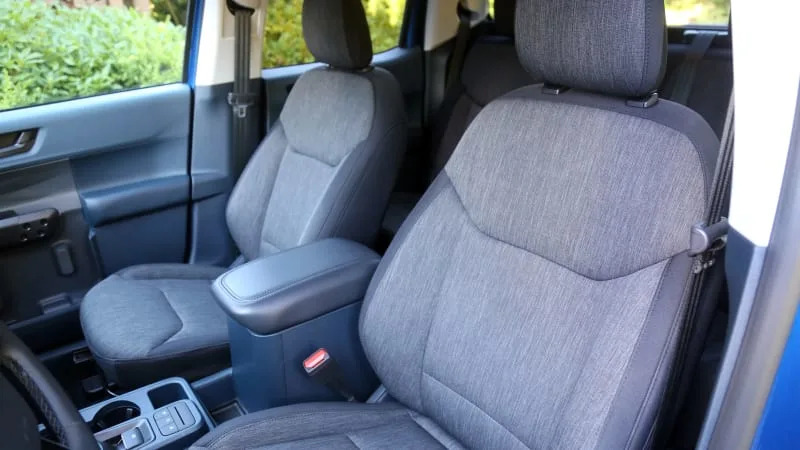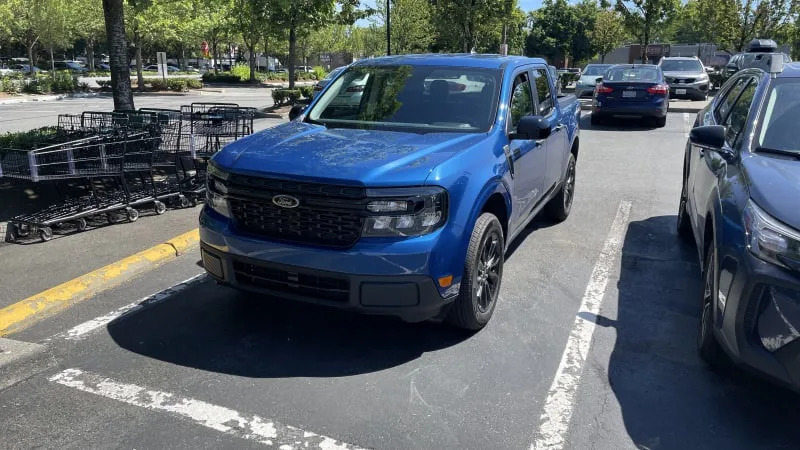The 2023 Ford Maverick is a simple mini truck we’ve driven and reviewed a few times now; I drove a non-hybrid a year ago, loaded a pretty good jag of bulk garden material into its little bed, and was impressed that it was truck enough to do light hauling duties for the average suburbanite. It’s filled with thoughtful design touches, such as all the ways Ford has compensated for the bed size, and the basic but hip interior.
But a version we hadn’t driven much is the Maverick Hybrid, the powerplant that caught everybody’s attention when the little truck was introduced. When the chance presented itself recently, we had one big question that hadn’t been answered in previous coverage: What kind of real-world mileage would the Maverick Hybrid get?
Here are five thoughts about this appealing little truck:
1. As the internet likes to say, try this one weird twist
And by twist, we’re talking an old-fashioned ignition key that you turn in the steering column. No newfangled start button here.
The non-hybrid XLT also has a key, and we’ve never given it a thought. But the Maverick Hybrid XLT combines this old-fangled technology with the relatively new-fangled technology of a hybrid powerplant — and that combination takes some getting used to. When you press the ignition button of a typical hybrid, you don’t have a reflexive expectation of anything other than the vehicle activating in some way or another. But when you turn an ignition key, and you’re a driver of a certain age, you have been conditioned by tens of thousands of key turns over a lifetime to expect an engine to fire up. So, when you key up the Maverick Hybrid and your ears are met with … nothing … your reaction every time is the same: “Oh crap, it won’t start. … Oh. Duh. It’s a hybrid.”
It’s funny how it only takes a split second for your mind to race to, “Geez, where are my jumper cables?” But once you realize the dashboard has come alive and all is well, you simply twiddle the shifter dial and take off under electric power. It took most of a week of outings for me to lose that reaction. That’s my problem, not the truck’s.
2. The Maverick Hybrid continues to be maddeningly hard to find
The Maverick Hybrid is such a great little rig, it’s no wonder it’s in such ridiculously high demand. A search of dealer inventories within a 50-mile radius turned up only nine Mavericks — none of them the hybrid, and virtually all showing dealer markups of $5,000-$9,000 over MSRP. Meanwhile, 39 Rangers were in stock, and 266 full-size F-150s.
The seeming inability to meet demand for the Maverick has given rise to a conspiracy theory that it’s all a ruse, and that Ford, or at least its dealers, would prefer to upsell you to a big, expensive truck rather than supply you with what you actually want. Let’s hope nobody’s actually that devious. The less cynical explanations are the lingering effects of the chip shortage, and Ford badly underestimating a staggering level of interest in an affordable small pickup. The company racked up 86,000 orders for the 2023 Maverick in just seven days before order-taking was shut down.

3. ‘Tis a gift to be simple
The interior of a Maverick in XLT trim is basic and spare, yet stylish. The materials are characterful, and the cabin is filled with useful cubbies. The non-hybrid I drove last year had an interior filled with orange accents, while this Maverick Hybrid was less busy in black and blue, pairing nicely with its Atlas Blue Metallic exterior. And some hard plastic on the dash that seemed weird to the touch in the first truck has either been softened a bit, or maybe I just got used to it. It’s fine.
I love how basic and no-nonsense the Maverick is in XLT trim. No complicated features. The eight-inch infotainment system is rudimentary; they don’t even call it Sync. Stereo? It works, you can catch the news on it. HVAC? Blows hot and cold, yep. It does have drive modes. And otherwise, well, that’s about it. The truck has what you need and nothing you couldn’t get along without. If this is how you make a vehicle affordable these days, then this is perfectly acceptable.

4. It’ll fit into any parking space
One of the best things about the Maverick is how easy it is to park. The week after the Maverick, it got swapped for a Chevy Silverado ZR2 AEV Bison, a truck that had to pass up many parking spaces. You can put the Maverick anywhere.
One detail that takes getting used to are the unusual interior door pulls. At one point, I parked, popped the door open, grabbed for the spot in space where there’d typically be something to hold onto, and came up with a handful of air, because on the Maverick the door handle ends in a stub. After flailing, I stopped the swing in the nick of time.
5. Most of all, the Maverick Hybrid gets great gas mileage
The EPA rates the Maverick Hybrid at 40 mpg city, 33 highway, 37 combined. Sounds impressive. Could it achieve those numbers IRL? Maybe even beat them?
A few days running suburban errands would reveal the answer. I wasn’t hardcore hypermiling but drove reasonably, like someone who is paying a bit of attention to the mileage he’s getting — which, if you’re interested in a Maverick Hybrid, you surely do.
I kept it in Normal mode, never dabbled with Eco. The truck didn’t get off easy with strictly flatland duties, either. I live on a hill with an elevation of 500 feet, and it’s steep enough that the road up has switchbacks, so the Maverick had to pull some grades. Though of course every trip off the hill was a regeneration goldmine.
There was a solid mix of surface streets and interstate, so the EPA combined rating of 37 mpg was the number to benchmark against.
The Maverick’s 2.5-liter four-cylinder is rated at 162 horsepower and 155 pound-feet of torque, with the electric motor contributing to a total of 191 horsepower. Ford, interestingly, does not cite a total torque number, but a Maverick forum member claims 267 pound-feet, at least for a short burst. No matter the actual numbers, the hybrid, which is the base powertrain, feels plenty good enough for its mission.
The cabin is quiet and comfortable, like any typical compact SUV. Transitions between electric and ICE power were imperceptible, the CVT was inoffensive as CVTs go, and the regenerative system just did its thing. A simple gauge lets you know if you’re recouping or expending energy.
No range anxiety here: The Maverick started out the week estimating its range at 550 miles.
With that 37 mpg as the number to beat, the dashboard readout started heading north of that – the mileage figure even climbed at highway speed, which is not usually a hybrid’s forte. Soon it was over 40 mpg. It hit 42.5 before settling back into the 41-something range.
But there’s always a chance that a dashboard computer is, how shall we say … generous, embellished, rigged? Case in point, Tesla’s accused of telling some whoppers with its range readout.
So, I pulled into a gas station for a fill-up to determine the Maverick’s actual fuel economy.
Which was: 44.0 miles per gallon.
The Maverick gets double the mileage of most full-size gasoline pickups — or even triple. It can’t do everything they do, but it can do some, occasionally. And maybe that’s all the capability you need.
Your mileage may, as you know … vary. Mine might, too. If I had tried harder, the little truck could’ve done even better. The federal government’s fueleconomy.org website has an underused feature — the ability for vehicle owners to report the mileage they’ve experienced. Two Maverick owners there claimed mileage of 47 mpg and 50.7. Conversely, if you drove the Maverick like you didn’t care, it’d probably still do OK.
The EPA estimates you’ll spend $1,450 a year on gasoline with a Maverick Hybrid, and save $2,500 in fuel costs over five years.
A Maverick Hybrid XL starts at $23,400. An XLT equipped like this particular truck (XLT Luxury package, black appearance package, Co-Pilot 360 assists, spray-in bedliner, all-weather mats) would cost you $30,625 including the $1,495 destination fee — that is, if you were able to get one at MSRP from an honorable dealership.
Three weeks after I found just nine Mavericks in inventory within a 50-mile radius, a fresh search turned up 22 of them, and five were hybrids. Dealer markups had fallen to as little as $3,000 over MSRP, though the hybrids were still getting marked up as much as $10K by the worst pirates. But the scarcity situation might be easing a bit — and your chance to grab a modestly priced, 40-mpg-plus pickup truck may happen someday.
Read the full article here


